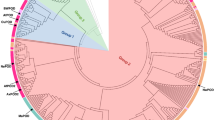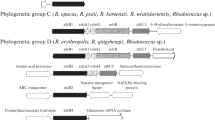Abstract
Alcaligenes faecalis IS-46 can utilize phenol as the sole carbon and energy source at concentration up to 1000 mg/l. In this report we created a cosmid library of this strain and the two clones specifying the whole L-46d type of phenol hydroxylase gene cluster were identified and characterized. Sequence analysis revealed that although the overall gene organization of the clusters was quite similar, few coding sequences differed or were found to have two copies compared with other source organisms. One of these coding sequences showed a good protein sequence similarity to a hypothetical protein and one matched with a regulatory protein of the LysR system. Their putative role in phenol degradation was discussed. Bioinformatic analysis suggested tentative phylogenetic assignments of the retrieved clusters. This work described for first time the complete nucleotide sequence and genetic organization of the whole phenol hydroxylase gene cluster in A. faecalis species.



Similar content being viewed by others
Abbreviations
- PH:
-
Phenol hydroxylase
- mPH:
-
Multicomponent phenol hydroxylase
- LmPH:
-
The largest subunit of the multicomponent phenol hydroxylase
- C23O:
-
Catechol 2,3-dioxygenase
- CatA:
-
Catechol 1,2-dioxygenase
- 2-HMS:
-
2-Hydroxymuconic semialdehyde
- ORF:
-
Open reading frame
- IS:
-
Insertion sequences
References
Arai H, Akahira S, Ohishi T, Maeda M, Kudo T (1998) Adaptation of Comamonas testosteroni TA441 to utilize phenol: organization and regulation of the genes involved in phenol degradation. Microbiology 144:2895–2903
Arai H, Ohishi T, Chang MY, Kudo T (2000) Arrangement and regulation of the genes for meta-pathway enzymes required for degradation of phenol in Comamonas testosteroni TA441. Microbiology 146:1707–1715
Cadieux E, Vrajmasu V, Achim C, Powlowski J, Münck E (2002) Biochemical, Mössbauer, and EPR studies of the diiron cluster of phenol hydroxylase from Pseudomonas sp. strain CF600. Biochemistry 41:10680–10691
Cafaro V, Izzo V, Scognamiglio R, Notomista E, Capasso P, Casbarra A, Pucci P, Di Donato A (2004) Phenol hydroxylase and toluene/o-xylene monooxygenase from Pseudomonas stutzeri OX1: interplay between two enzymes. Appl Environ Microbiol 70:2211–2219
Di Gioia D, Peel M, Fava F, Wyndham RC (1998) Structures of homologous composite transposons carrying cbaABC genes from Europe and North America. Appl Environ Microbiol 64:1940–1946
Divari S, Valetti F, Caposio P, Pessione E, Cavaletto M, Griva E, Gribaudo G, Gilardi G, Giunta C (2003) The oxygenase component of phenol hydroxylase from Acinetobacter radioresistens S13. Eur J Biochem 270:2244–2253
Duffner FM, Muller R (1998) A novel phenol hydroxylase and catechol 2,3-dioxygenase from the thermophilic Bacillus thermoleovorans strain A2: nucleotide sequence and analysis of the genes. FEMS Microbiol Lett 161:37–45
Ehrt S, Schirmer F, Hillen W (1995) Genetic organization, nucleotide sequence and regulation of expression of genes encoding phenol hydroxylase and catechol 1,2-dioxygenase in Acinetobacter calcoaceticus NCIB8250. Mol Microbiol 18:13–20
Folsom BR, Chapman PJ, Pritchard PH (1990) Phenol and trichloroethylene degradation by Pseudomonas cepacia G4: kinetics and interactions between substrates. Appl Environ Microbiol 56:1279–1285
Futamata H, Harayama S, Watanabe K (2001) Group-specific monitoring of phenol hydroxylase genes for a functional assessment of phenol-stimulated trichloroethylene bioremediation. Appl Environ Microbiol 67:4671–4677
Herrmann H, Muller C, Schmidt I, Mahnke J, Petruschka L, Hahnke K (1995) Localization and organization of phenol degradation genes of Pseudomonas putida strain H. Mol Gen Genet 247:240–246
Hino S, Watanabe K, Takahashi N (1998) Phenol hydroxylase cloned from Ralstonia eutropha strain E2 exhibits novel kinetic properties. Microbiology 144:1765–1772
Jeong JJ, Kim JH, Kim CK, Hwang I, Lee K (2003) 3- and 4-alkylphenol degradation pathway in Pseudomonas sp. strain KL28: genetic organization of the lap gene cluster and substrate specificities of phenol hydroxylase and catechol 2,3-dioxygenase. Microbiology 149:3265–3277
Jiang Y, Wen J, Caiyin Q, Lin L, Hu Z (2006) Mutant AFM 2 of Alcaligenes faecalis for phenol biodegradation using He-Ne laser irradiation. Chemosphere 65:1236–1241
Johnson GR, Olsen RH (1995) Nucleotide sequence analysis of genes encoding a toluene/benzene-2-monooxygenase from Pseudomonas sp. strain JS150. Appl Environ Microbiol 61:3336–3346
Kahng HY, Malinverni JC, Majko MM, Kukor JJ (2001) Genetic and functional analysis of the tbc operons for catabolism of alkyl- and chloroaromatic compounds in Burkholderia sp. strain JS150. Appl Environ Microbiol 67:4805–4816
Keen NT, Tamaki S, Kobayashi D, Trollinger D (1988) Improved broad-host-range plasmids for DNA cloning in gram-negative bacteria. Gene 70:191–197
Kim IC, Oriel PJ (1995) Characterization of the Bacillus stearothermophilus BR219 phenol hydroxylase gene. Appl Environ Microbiol 61:1252–1256
Kim Y, Ayoubi P, Harker AR (1996) Constitutive expression of the cloned phenol hydroxylase gene(s) from Alcaligenes eutrophus JMP134 and concomitant trichloroethylene oxidation. Appl Environ Microbiol 62:3227–3233
Kumar S, Tamura K, Jakobsen IB, Nei M (2001) MEGA2: molecular evolutionary genetics analysis software. Bioinformatics 17:1244–1245
Liang Q, Takeo M, Chen M, Zhang W, Xu Y, Lin M (2005) Chromosome-encoded gene cluster for the metabolic pathway that converts aniline to TCA-cycle intermediates in Delftia tsuruhatensis AD9. Microbiology 151:3435–3446
Marmur J (1961) A procedure for the isolation of deoxyribonucleic acid from microorganisms. J Mol Biol 3:208–218
Merimaa M, Heinaru E, Liivak M, Vedler E, Heinaru A (2006) Grouping of phenol hydroxylase and catechol 2,3-dioxygenase genes among phenol- and p-cresol-degrading Pseudomonas species and biotypes. Arch Microbiol 186:287–296
Nakamura K, Ishida H, Iizumi T (2000) Constitutive trichloroethylene degradation led by tac promoter chromosomally integrated upstream of phenol hydroxylase genes of Ralstonia sp. KN1 and its nucleotide sequence analysis. J Biosci Bioeng 89:47–54
Ng LC, Shingler V, Sze CC, Poh CL (1994) Cloning and sequences of the first eight genes of the chromosomally encoded (methyl) phenol degradation pathway from Pseudomonas putida P35X. Gene 151:29–36
Nojiri H, Shintani M, Omori T (2004) Divergence of mobile genetic elements involved in the distribution of xenobiotic-catabolic capacity. Appl Microbiol Biotechnol 64:154–174
Nordlund I, Powlowski J, Shingler V (1990) Complete nucleotide sequence and polypeptide analysis of multicomponent phenol hydroxylase from Pseudomonas sp. strain CF600. J Bacteriol 172:6826–6833
Peters M, Heinaru E, Talpsep E, Wand H, Stottmeister U, Heinaru A, Nurk A (1997) Acquisition of a deliberately introduced phenol degradation operon, pheBA, by different indigenous Pseudomonas species. Appl Environ Microbiol 63:4899–4906
Polissi A, Harayama S (1993) In vivo reactivation of catechol 2,3-dioxygenase mediated by a chloroplast-type ferredoxin: a bacterial strategy to expand the substrate specificity of aromatic degradative pathways. EMBO J 12:3339–3347
Rehfuss M, Urban J (2005) Alcaligenes faecalis subsp. phenolicus subsp. nov. a phenol-degrading, denitrifying bacterium isolated from a graywater bioprocessor. Syst Appl Microbiol 28:421–429
Sambrook J, Fritsch EF, Maniatis T (1989) Molecular cloning: a laboratory manual, 2nd edn, Cold Spring Harbor Laboratory Press, Cold Spring Harbor, New York
Santos PM, Sá-Correia I (2007) Characterization of the unique organization and co-regulation of a gene cluster required for phenol and benzene catabolism in Pseudomonas sp. M1. J Biotechnol 131:371–378
Shingler V, Powlowski J, Marklund U (1992) Nucleotide sequence and functional analysis of the complete phenol/3,4-dimethylphenol catabolic pathway of Pseudomonas sp. strain CF600. J Bacteriol 174:711–724
Springael D, Ryngaert A, Merlin C, Toussaint A, Mergeay M (2001) Occurrence of Tn4371-related mobile elements and sequences in (chloro) biphenyl-degrading bacteria. Appl Environ Microbiol 67:42–50
Takeo M, Maeda Y, Okada H, Miyama K, Mori K, Ike M, Fujita M (1995) Molecular cloning and sequencing of the phenol hydroxylase gene from Pseudomonas putida BH. J Ferment Bioeng 79:485–488
Takeo M, Prabu SK, Kitamura C, Hirai M, Takahashi H, Kato D, Negoro S (2006) Characterization of alkylphenol degradation gene cluster in Pseudomonas putida MT4 and evidence of oxidation of alkylphenols and alkylcatechols with medium-length alkyl chain. J Biosci Bioeng 102:352–361
Tan HM (1999) Bacterial catabolic transposons. Appl Microbiol Biotechnol 51:1–12
Teramoto M, Futamata H, Harayama S, Watanabe K (1999) Characterization of a high-affinity phenol hydroxylase from Comamonas testosteroni R5 by gene cloning, and expression in Pseudomonas aeruginosa PAO1c. Mol Gen Genet 262:552–558
Thompson JD, Gibson TJ, Plewniak F, Jeanmougin F, Higgins DG (1997) The CLUSTAL_X windows interface: flexible strategies for multiple sequence alignment aided by quality analysis tools. Nucleic Acids Res 25:4876–4882
Top EM, Springael D (2003) The role of mobile genetic elements in bacterial adaptation to xenobiotic organic compounds. Curr Opin Biotechnol 14:262–269
Watanabe K, Futamata H, Harayama S (2002) Understanding the diversity in catabolic potential of microorganisms for the development of bioremediation strategies. Antonie Van Leeuwenhoek 81:655–663
Watanabe K, Hino S, Onodera K, Kajie SI, Takahashi N (1996) Diversity in kinetics of bacterial phenol-oxygenating activity. J Ferment bioeng 81:560–563
Watanabe K, Teramoto M, Futamata H, Harayama S (1998) Molecular detection, isolation, and physiological characterization of functionally dominant phenol-degrading bacteria in activated sludge. Appl Environ Microbiol 64:4396–4402
Xu Y, Chen M, Zhang W, Lin M (2003) Genetic organization of genes encoding phenol hydroxylase, benzoate 1,2-dioxygenase alpha subunit and its regulatory proteins in Acinetobacter calcoaceticus PHEA-2. Curr Microbiol 46:235–240
Zhang X, Gao P, Chao Q, Wang L, Senior E, Zhao L (2004) Microdiversity of phenol hydroxylase genes among phenol-degrading isolates of Alcaligenes sp. from an activated sludge system. FEMS Microbiol Lett 237:369–375
Zouari H, Moukha S, Labat M, Sayadi S (2002) Cloning and sequencing of a phenol hydroxylase gene of Pseudomonas pseudoalcaligenes strain MH1: a bacterium able to mineralize various aromatic compounds. Appl Biochem Biotechnol 102–103:261–276
Acknowledgements
This work was supported by the grants from the National Natural Science Foundation of China (30470061 and 20677041) and the Shanghai Rhone-Alpes bilateral collaboration project of Shanghai Municipal Committee of Science and Technology (05SR07107). The authors thank Dr. He Xinyi and Dr. Zhang Yan for recommendation of gene cloning and screening protocols, Dr. Zhang Xueli (Univ. of Florida, USA) for critical reading of the manuscript.
Author information
Authors and Affiliations
Corresponding author
Rights and permissions
About this article
Cite this article
Zhu, C., Zhang, L. & Zhao, L. Molecular cloning, genetic organization of gene cluster encoding phenol hydroxylase and catechol 2,3-dioxygenase in Alcaligenes faecalis IS-46. World J Microbiol Biotechnol 24, 1687–1695 (2008). https://doi.org/10.1007/s11274-008-9660-3
Received:
Accepted:
Published:
Issue Date:
DOI: https://doi.org/10.1007/s11274-008-9660-3




